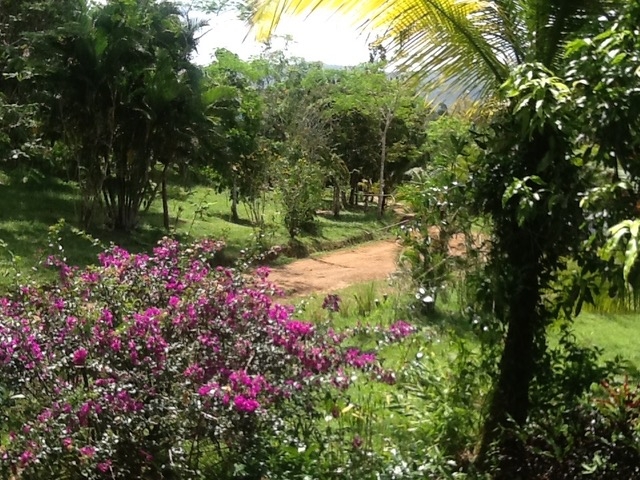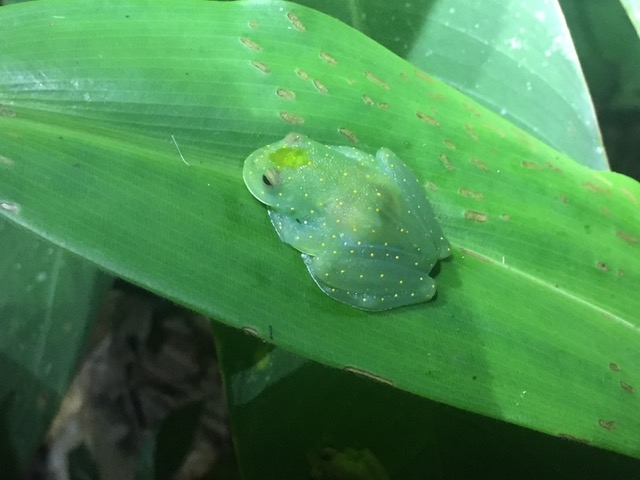A Day in the Field: Notes from Panamá
April 19, 2017
Written by Lisa Belden, with IGC fellows Daniel Medina and Angie Estrada.
Sunday, 7:46am
I am chugging café con leche and downing a whole plate of fresh papaya and pineapple while I wait for Dani to pick me up at the hotel. It was a late night, with a delayed flight from Atlanta to Panama City, but I am anxious to get out to the field with Dani and Angie today. Dani arrives and we weave our way through crazy traffic heading east out of the city. Every bus stop has a fruit stand and I implore Dani to stop for guanabana, my favorite tropical fruit, but he says it is too dangerous to pull over at the bus stops, and after watching a few buses pull in and out, I have to admit he is probably right.* We eventually leave the highway at a small town and stop to buy a few giant avocados en route to the field station. A few river and stream crossings later, and we arrive in a tropical paradise.

Sunday, 11:15am
Dani and I are waiting in the open air "comedor" for Angie to return from scouting out a field site. When she gets there, she immediately starts cooking. We have a great lunch of tortillas and chorizo, with some of our recently acquired avocado. After lunch, Dani and Angie start packing for the hike to the field site. They are doing an important conservation project here—seeing if endangered toads that have been raised in captivity can survive at a site where they used to live. The hardest part of the project, hauling all the enclosures to the site (one per toad) and putting in the toads, was done a few days ago. Today we are going to go check on the toads and swab them, so we can monitor potential infection by chytrid fungus, the skin pathogen that likely drove this species to the brink of extinction in the first place. That swab will also allow us to assess the other microbes on their skin, so we can see how their symbiotic skin microbes change following re-introduction. We think these microbes might play a role in disease resistance, and so we want to track how they might change over time in the field in these toads that are so susceptible to chytrid fungus.



Sunday, 2:23pm
We are hiking up a very steep trail, just outside of the station. I stop to look at a frog (or maybe just to catch my breath). There is so much life in the lowland tropics-- so many things to see. Hiking in a tropical forest, as a lover of biodiversity, is like no other experience. Every step brings something new to see… a frog leaping from underfoot, a giant caterpillar, a gorgeous orchid on a branch overhead, an amazing mushroom growing out of a stump, a flock of birds that make a ridiculous amount of noise but can't be seen, the slightly eery sound of howler monkeys in the distance. We stop to watch two pied puff birds that look like small black and white kingfishers. They are sitting on a branch right next to the trail, near a termite mound and they seem as curious about us as we are about them. We keep moving and are headed downhill now, to a stream. We walk down this stream, on slippery boulders and large cobbles. Dani points out a small frog carrying tadpoles on her back, looking for a place to put them in the stream. It seems a precarious venture for such a small creature in a big stream, and I wish her well. We climb down the edge of a small waterfall that looks like it should be on a postcard, and soon we arrive at a larger stream, where the enclosures are, and the toads. It took an hour to get here and we have a lot to do, so we find the first enclosure downstream and get to work. Dani and Angie carefully check and swab each toad. Most are hiding in the leaf litter inside the enclosures, which is damp to the touch. I watch my students, trying to help a little where I can, and listen to the sounds of the forest—I am reminded of how much I love being in the field, and how that used to be a much bigger part of my job.


Sunday, 5:37pm
"Does everyone have extra batteries for their headlamps?" Angie asks. Dusk is rapidly approaching and we still have about 10 frogs left to swab. We are walking upstream to the next set of enclosures, which are spaced out along the banks as the stream topography allows. I pause momentarily, and Angie says, "Keep walking, please", with a bit of urgency. I move forward as my brain ticks off the things that might have produced that tone in her voice. Fer-de-lance, bullet ants, jaguar… That is as far as I get on my list before Angie points out the coral snake climbing through some short palms to our right at about shoulder height. It is beautiful with its bands of red, yellow and black, and they aren't aggressive snakes, so I stop to enjoy it for a moment.** When we arrive at the next enclosure it is nearly dark, and the loud squawking of blue-headed parrots is filling the dusky jungle. Soon it is completely dark, and we are working by headlamp to the plinking calls of hopeful male glassfrogs. The toads are sleeping on top of the palm fronds in their enclosures now that it is dark, so they are easier to find as we finish up our work.

Sunday, 10:32pm
It took us 90 minutes to get back to the field station from the end of the enclosure transect. We walked very carefully, eyes staring for vipers in the leaf litter on the trail as if it was a magic eyes illusion that would spring to life at any instant. At one point, Angie stopped to point out a large tree with a sparse line of bullet ants climbing it, and a few seconds later we all skirted around a bullet ant crossing the trail. We have nothing but respect for the insects given a "4+" for the pain of their sting on a 4-point scale. After shockingly cold showers, we had peanut butter, bananas and crackers for dinner, and maybe a little rum. I climb into my hammock for the night, feeling grateful that I have the opportunity to be here for a few days with these two amazing graduate students in this incredible forest.






